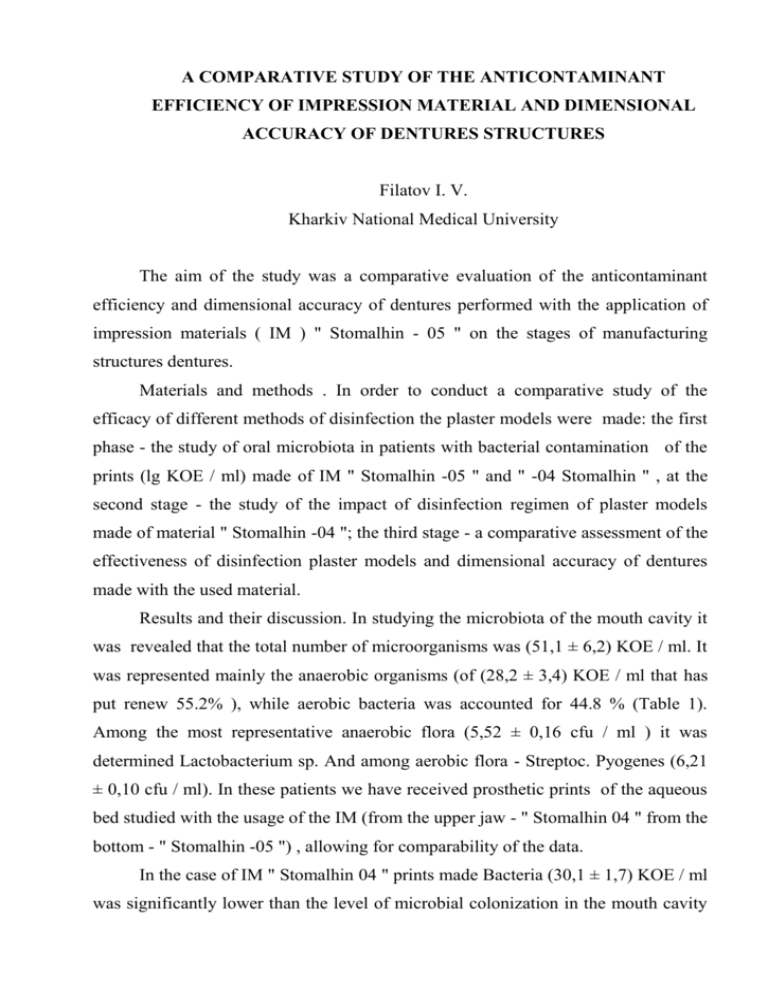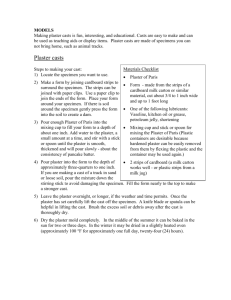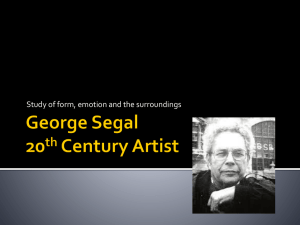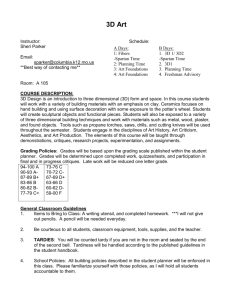A COMPARATIVE STUDY of the anticontaminant EFFICIENCY of
advertisement

A COMPARATIVE STUDY OF THE ANTICONTAMINANT EFFICIENCY OF IMPRESSION MATERIAL AND DIMENSIONAL ACCURACY OF DENTURES STRUCTURES Filatov I. V. Kharkiv National Medical University The aim of the study was a comparative evaluation of the anticontaminant efficiency and dimensional accuracy of dentures performed with the application of impression materials ( IM ) " Stomalhin - 05 " on the stages of manufacturing structures dentures. Materials and methods . In order to conduct a comparative study of the efficacy of different methods of disinfection the plaster models were made: the first phase - the study of oral microbiota in patients with bacterial contamination of the prints (lg KOE / ml) made of IM " Stomalhin -05 " and " -04 Stomalhin " , at the second stage - the study of the impact of disinfection regimen of plaster models made of material " Stomalhin -04 "; the third stage - a comparative assessment of the effectiveness of disinfection plaster models and dimensional accuracy of dentures made with the used material. Results and their discussion. In studying the microbiota of the mouth cavity it was revealed that the total number of microorganisms was (51,1 ± 6,2) KOE / ml. It was represented mainly the anaerobic organisms (of (28,2 ± 3,4) KOE / ml that has put renew 55.2% ), while aerobic bacteria was accounted for 44.8 % (Table 1). Among the most representative anaerobic flora (5,52 ± 0,16 cfu / ml ) it was determined Lactobacterium sp. And among aerobic flora - Streptoc. Pyogenes (6,21 ± 0,10 cfu / ml). In these patients we have received prosthetic prints of the aqueous bed studied with the usage of the IM (from the upper jaw - " Stomalhin 04 " from the bottom - " Stomalhin -05 ") , allowing for comparability of the data. In the case of IM " Stomalhin 04 " prints made Bacteria (30,1 ± 1,7) KOE / ml was significantly lower than the level of microbial colonization in the mouth cavity and significantly greater than bacterial contamination of prints obtained with the usage of IM " Stomalhin -05 "( respectively 51,1 ± 6,2 and 24,1 ± 1,8 CFU / ml). It was revealed that regardless of the type of impression materials applied in the structure of bacterial contamination of IM the dominated form of anaerobic microorganisms ( respectively 16,9 ± 0,9 and 14,2 ± 0,8 KOE / ml). However the usage of IM " Stomalhin -04 " did not provide quantitative changes in two types of microorganisms , such as : Candida albicans, Staphylococcus Aureus, while plasterchewing performance material " Stomalhin -05 " has manifested a significant decrease in the levels of bacterial contamination of prints for all types of microorganisms . The efficiency of disinfection was evaluated on the prints obtained from the application of the material " Stomalhin -04 ", for which they were soaked in reagent ( aqueous glutaraldehyde ) and every 5 min washings performed for further microbiological study. After 15 minutes of the start of decontamination overall bacterial contamination plaster model was 4,6 ± 0,08 KOE/ ml and was significantly (p ≤ 0,001) different levels of colonization in her 5 and 10 minutes disinfection (respectively 22,8 ± 0,21 and 11,2 ± 0,09 KOE / ml). It was also noted that the level of microbial colonization of plaster models represented with IM " Stomalhin 04 " for 15 min disinfection remained significantly (p ≤ 0,05) higher levels of colonization plaster models obtained on the printout of the IM " Stomalhin -05 ." In addition, depending on the method of disinfection , different microbial and bacterial contamination landscape plaster models : a version of the application IM " Stomalhin -04 " on the plaster models colonization represented by 5 species: Peptostreptococcus sp. - 1,15 ± 0,12 KOE / mL, Candida albicans - 1,05 ± 0,05 KOE / ml, Staphylococcus Saprophyticus - 1,50 ± 0,10 KOE / ml, StreptococcusPyogenes - 1,45 ± 0,05 KOE / ml and Corynebacterium sp. - 1,00 ± 0,10 KOE / ml. In the case of application of IM " Stomalhin - 05 " anaerobic flora was represented: Lactobacterium sp., Staphylococcus Epidermidis, Streptococcus Mitis ( all by 1,10 ± 0,05 KOE / ml). As the plaster model for prints of IM " Stomalhin 04 " requires additional decontamination it was clear in the experiment that an additional disinfection has reduced the level of bacterial contamination of plaster models and has altered the microbial landscape of bacterial contamination. However comparatively with the method of application of IM with disinfecting effect the usage of decontamination techniques plaster models with IM " Stomalhin -04 " did not provide the required level of disinfection ; while maintaining a dangerous application of IM pathogenic flora. The "Stomalhin -05 " has provided the basic disinfection of pathogenic microflora and its minimal possible presence ( both quantitatively and qualitatively ) on plaster models . And the exclusion procedure wetting in aqueous disinfectant solution could affect the accuracy of the adequate plaster models. Accuracy prints compared on the basic parameters whose valueswere obtained by measuring the diameter of each cylinder plaster model; receipt prints – usage of disposable plastic impression Tano spoons ; to ensure contact between the impression spoon were used the IM impression spoon with perforations. It was found that the lowest values of finite dimensional accuracy ( LMV ) were characterized by technological options for IM application of " Stomalhin -05 " in combination with plaster GC Fujirock EP; meaning LMV varied in the range of 0.29 % to 1.63 % of the linear size of the support elements. In this case it was noted that depending on the type of support elements , the optimal selection of technological cast version - IM could vary. So to get the most accurate models of molars , premolars and incisors it was optimal to use IM " Stomalhin - 05 " in combination with the plaster GC Fujirock EP, while canines – the usage of the plaster GV -B -11. Comparing the dimensional accuracy of the designs produced using IM " Stomalhin -04 " and " 05 - Stomalhin " in selected technological options it was noted that the best for " Stomalhin -04 " was a technological option with the application of GW -G- 10 - A III ( error is 0.04% ), whereas in the case of " Stomalhin -05 " – the plaster GC Fujirock EP. This could be explained by the fact that in the first case, disinfection was done by wetting imprint in aqueous solution, lead to a changed in size, and the second - the process of wetting was excluded. Conclusions: 1. Extent of contamination is determined by the materials used prints. In particular , the usage of IM " Stomalhin -05 " reduced (comparatively to the oral microbiota ) the degree of contamination of prints more than twice: from 51,1 ± 6,2 to 24,1 ± 1,8 KOE / ml. 2. The usage of IM " Stomalhin -05 " has provided the necessary disinfection of the main types of microbiota and its minimal possible persistence ( both quantitatively and qualitatively ) on the plaster. And the exclusion procedure by wetting in aqueous disinfectant solution has its positive effect on development of the dimensional accuracy of plaster models. 3. The best compliance of IM " Stomalhin -05 " was determined in the maximum dimensional accuracy of the usage of plaster GC Fujirock EP, which has provided the high accuracy at the level of 99.3% of the linear dimensions of the support elements. The slightly less accurate model could be obtained by application of the plaster GW -G- 10 A -III ( error is 1.09 %). Key words: impession dental material, decontamination, dimensional accuracy of the constructions, efficiency.


![First Aid Training : Bronze [Power Point]](http://s2.studylib.net/store/data/005424634_1-e0b0e5e602f7c1666ebc2e9ff3f4a1b5-300x300.png)



